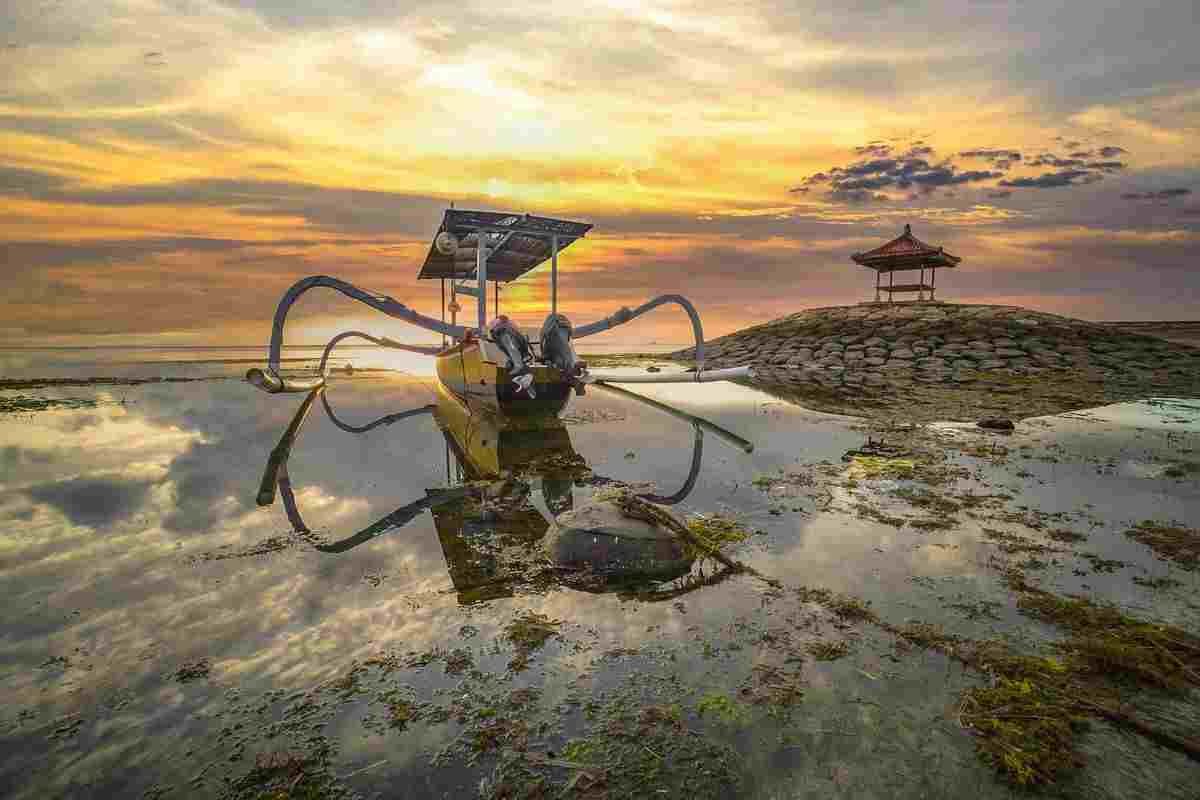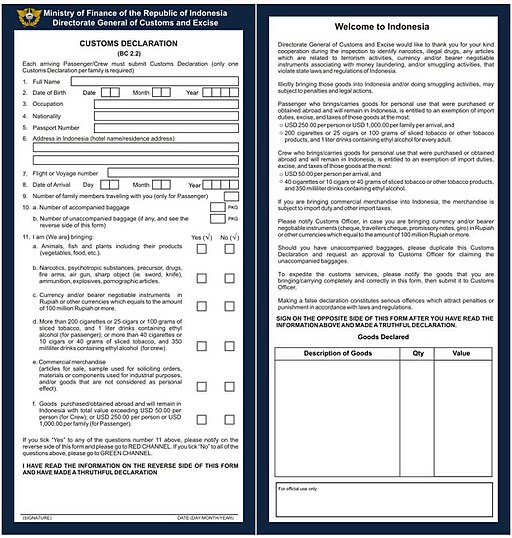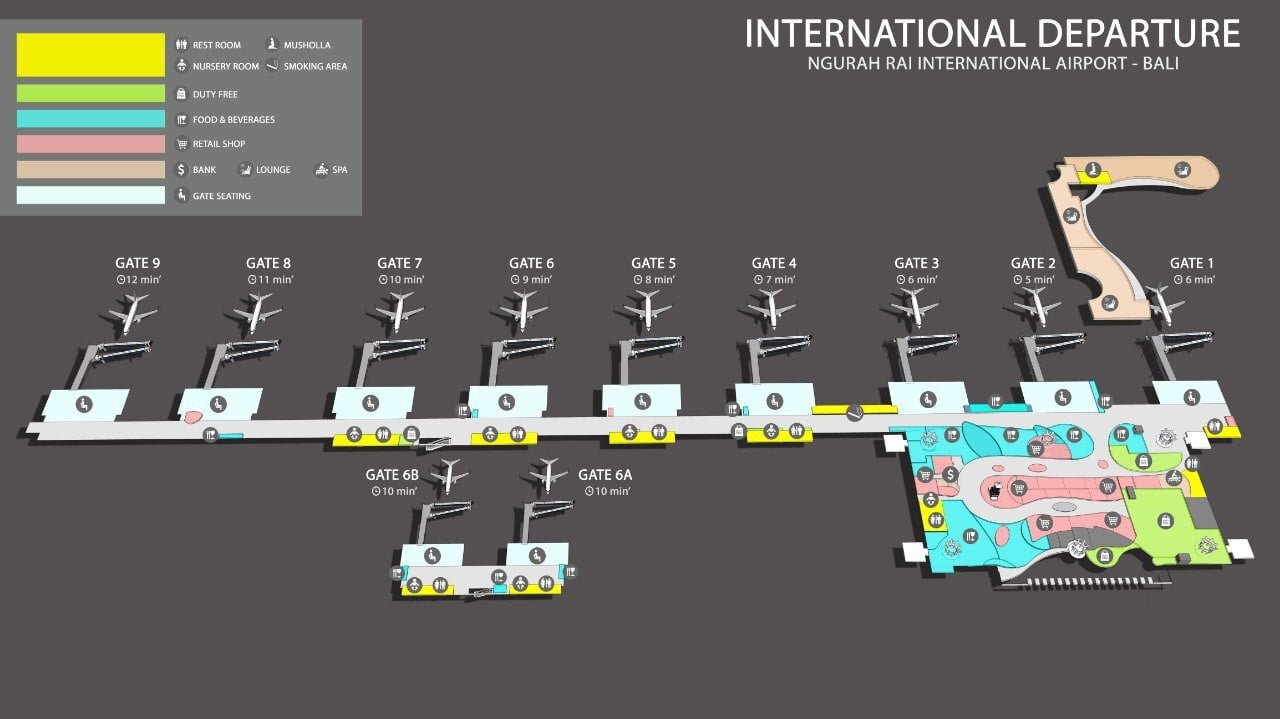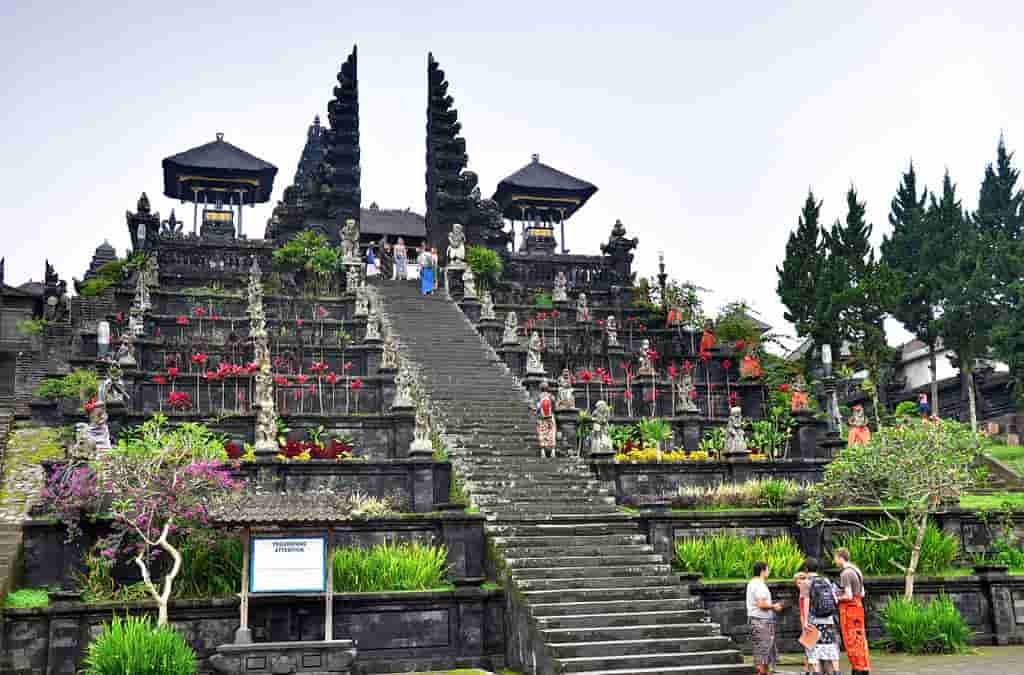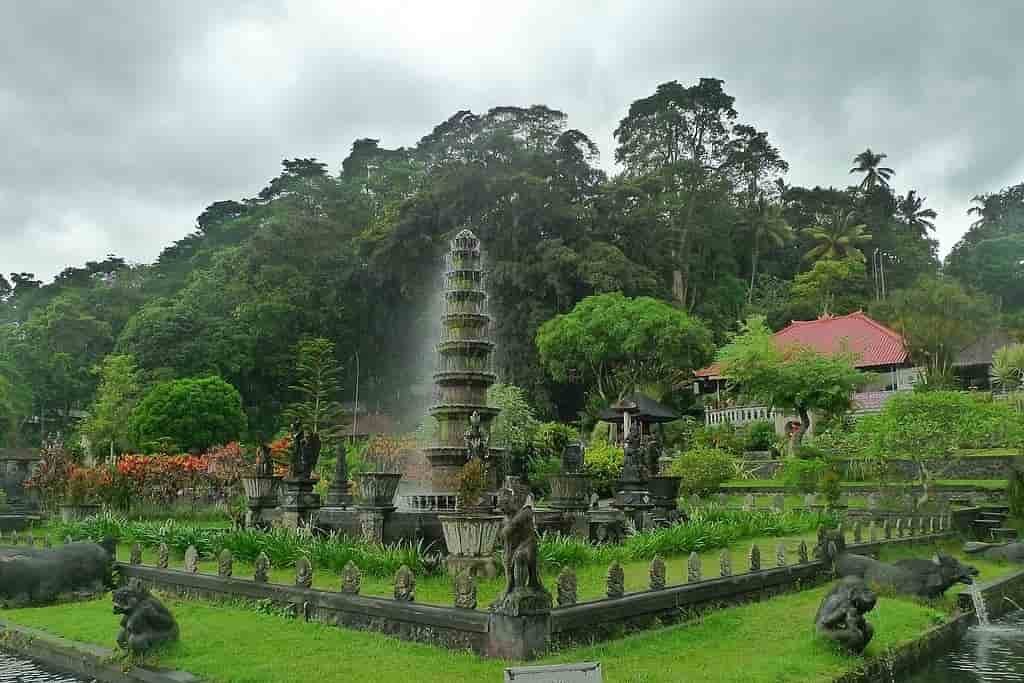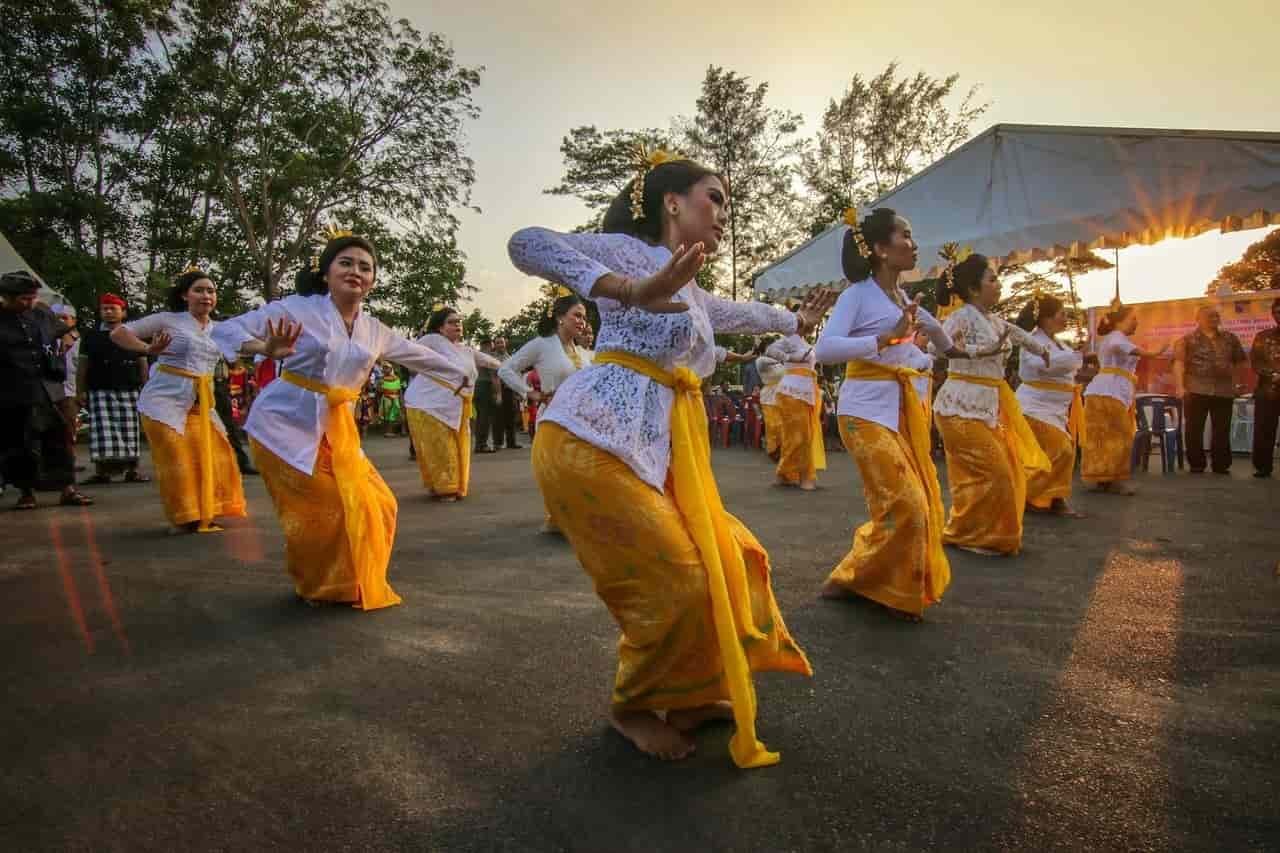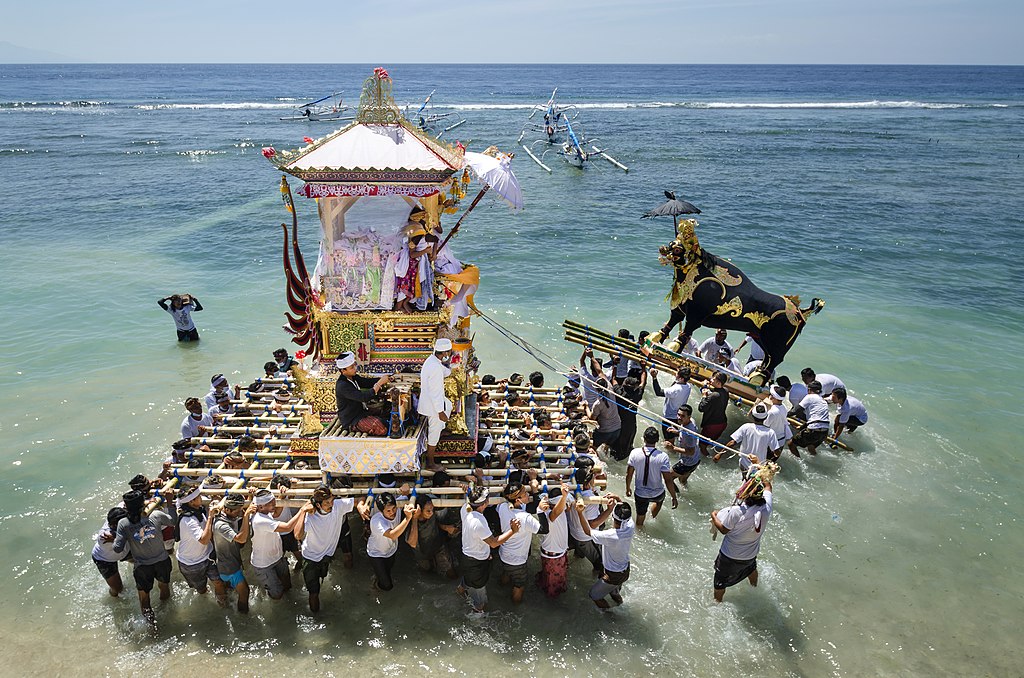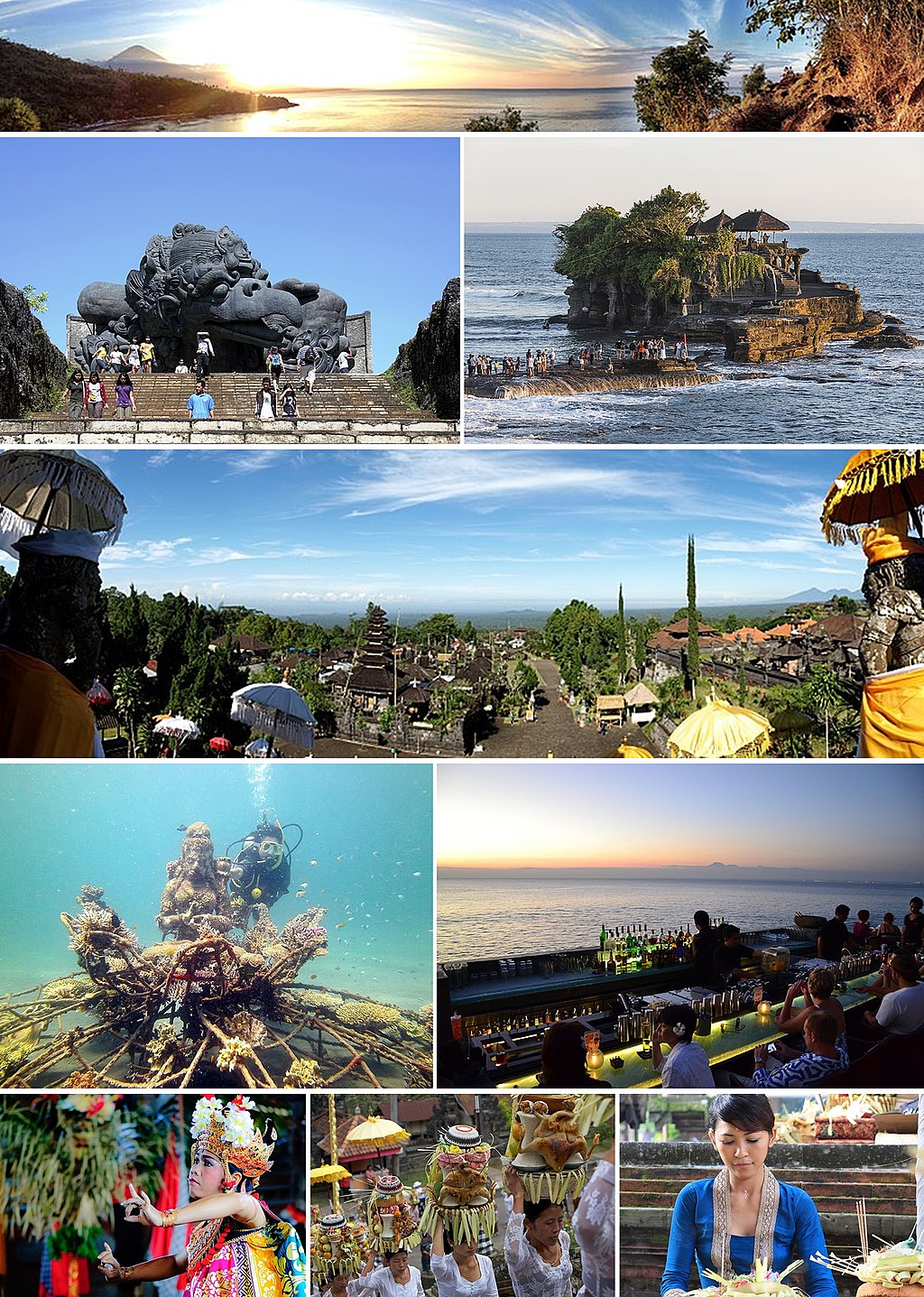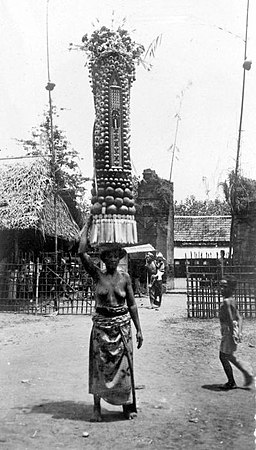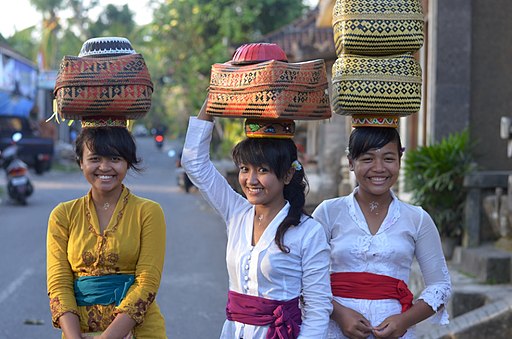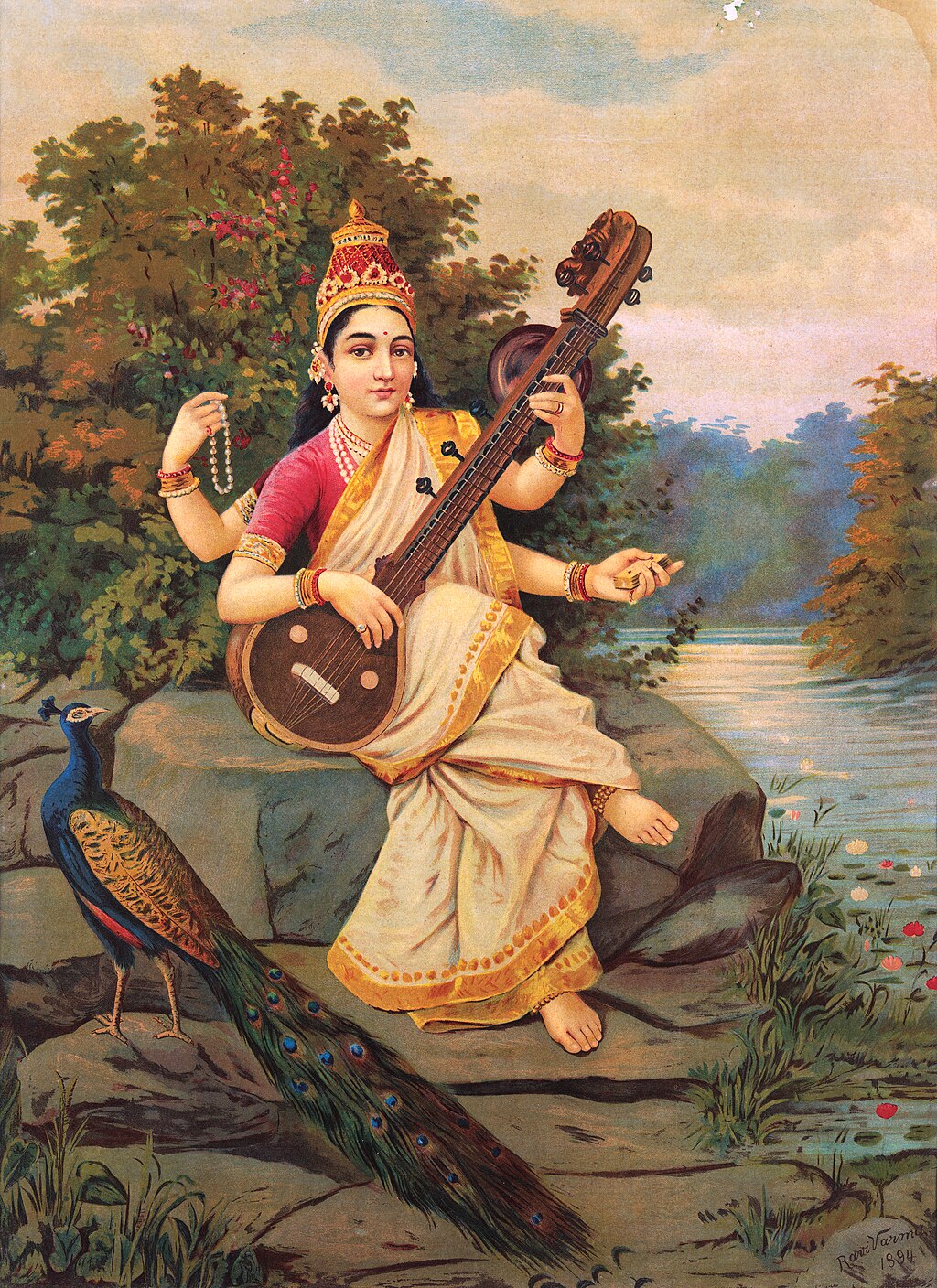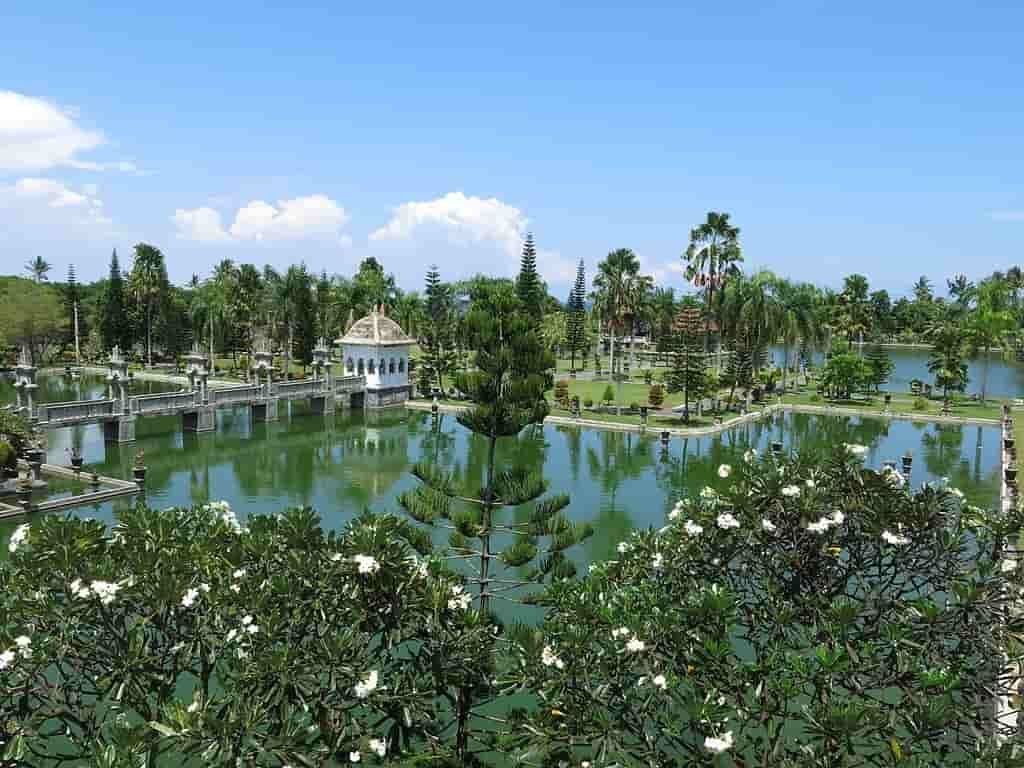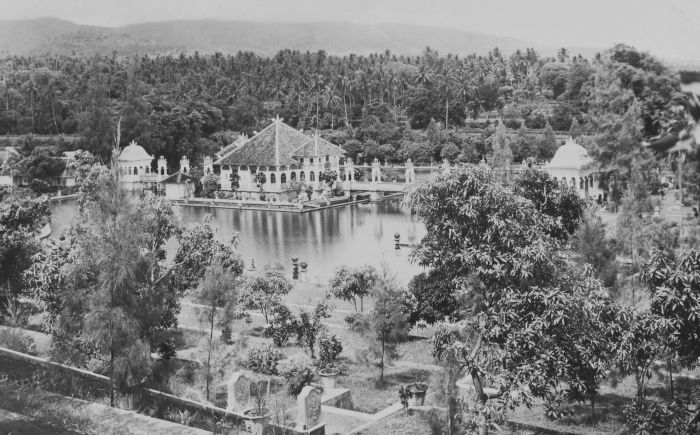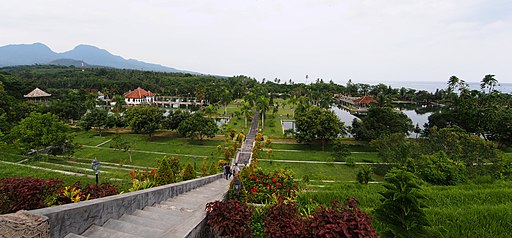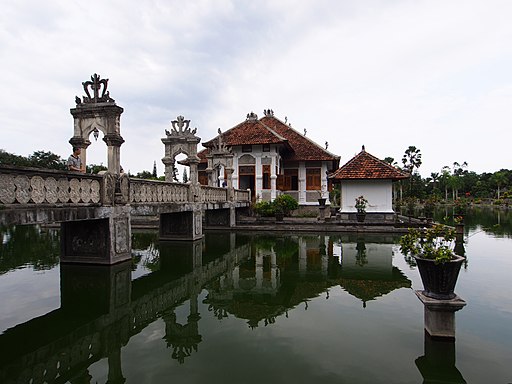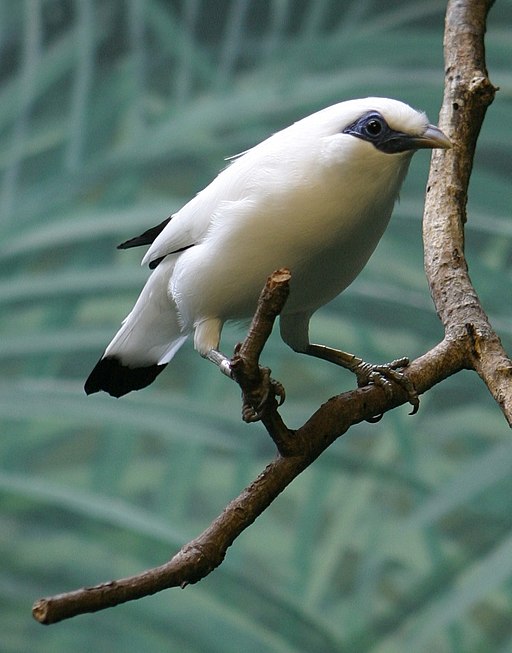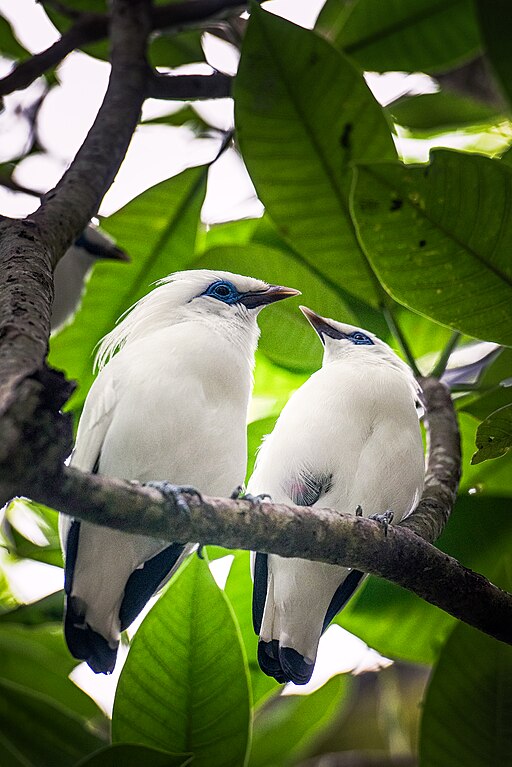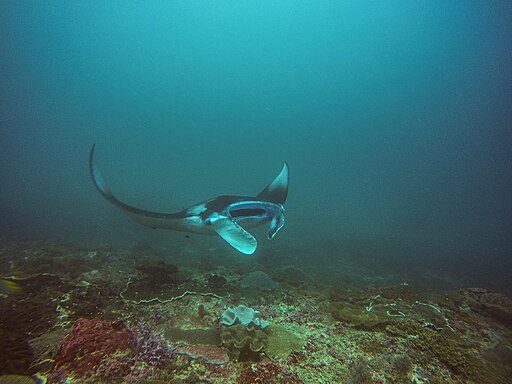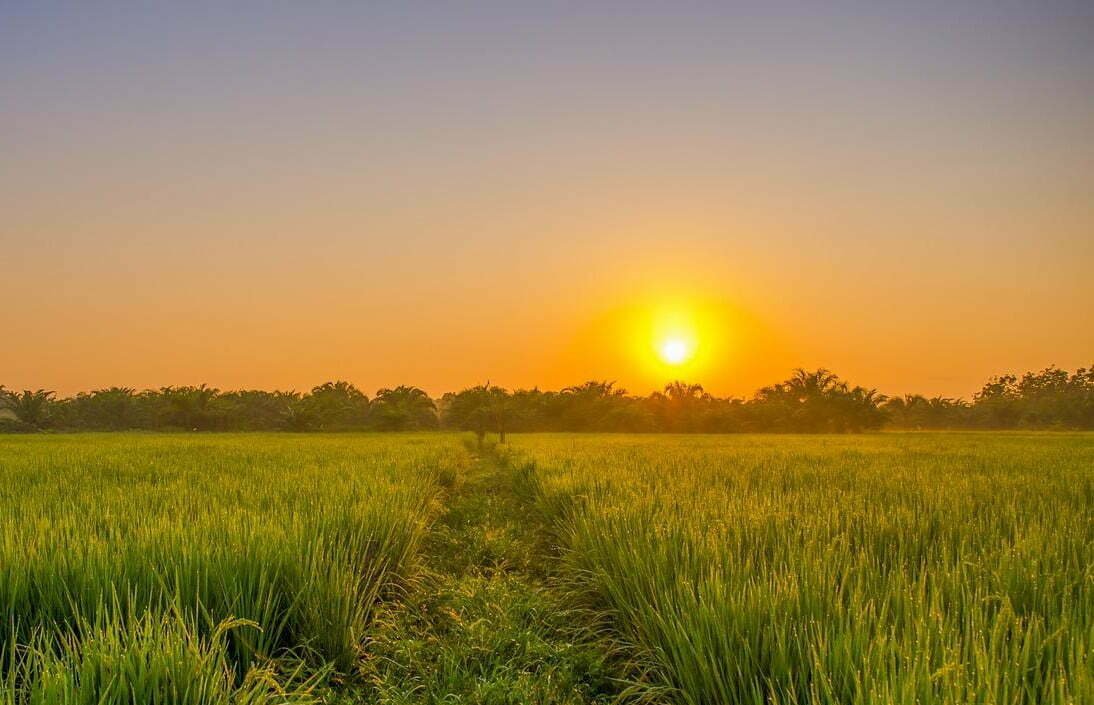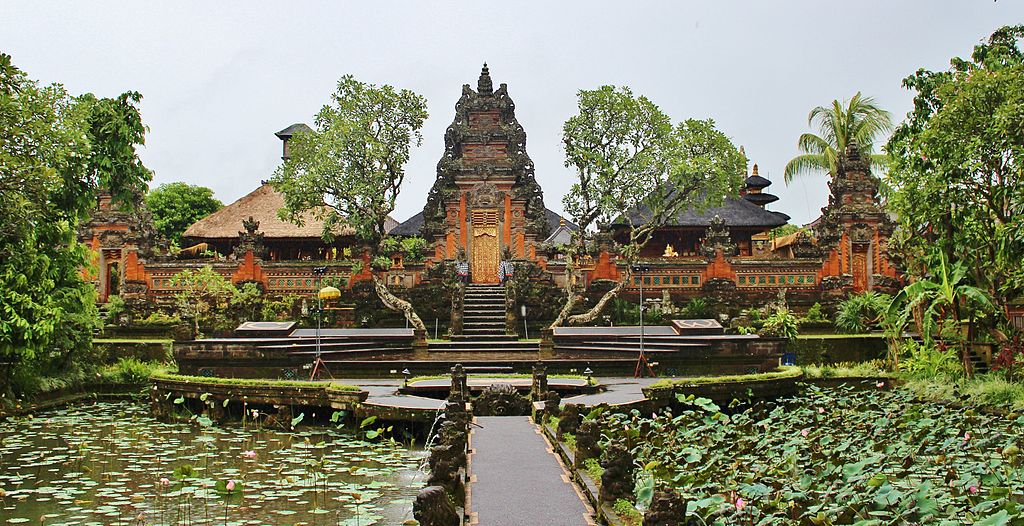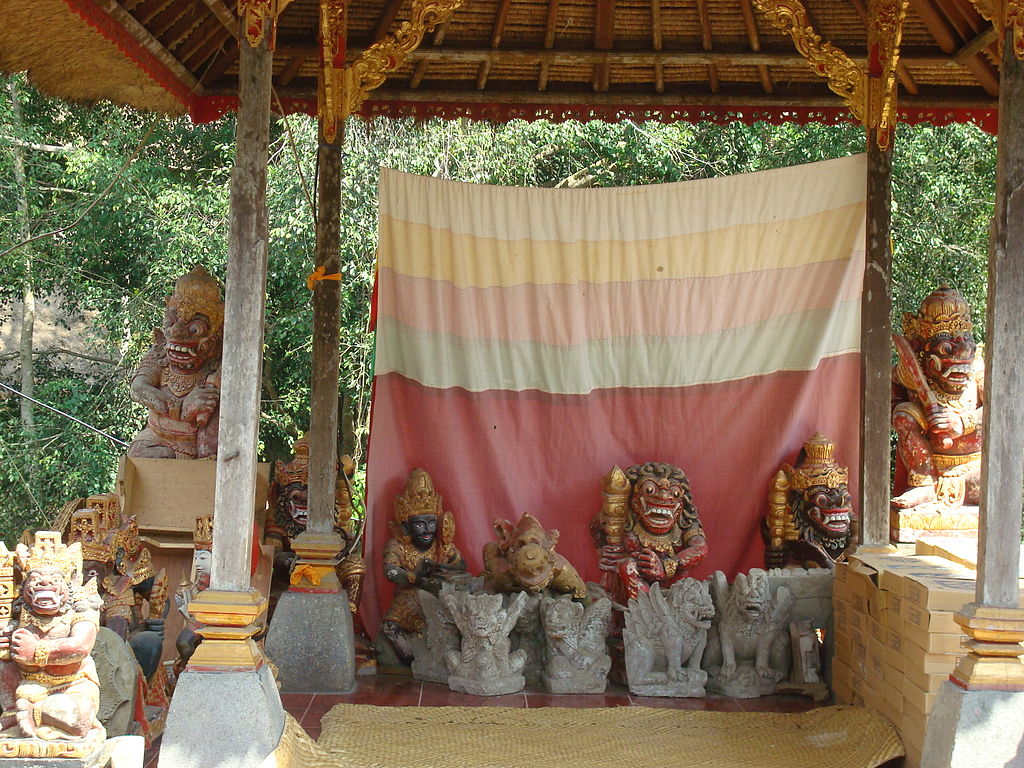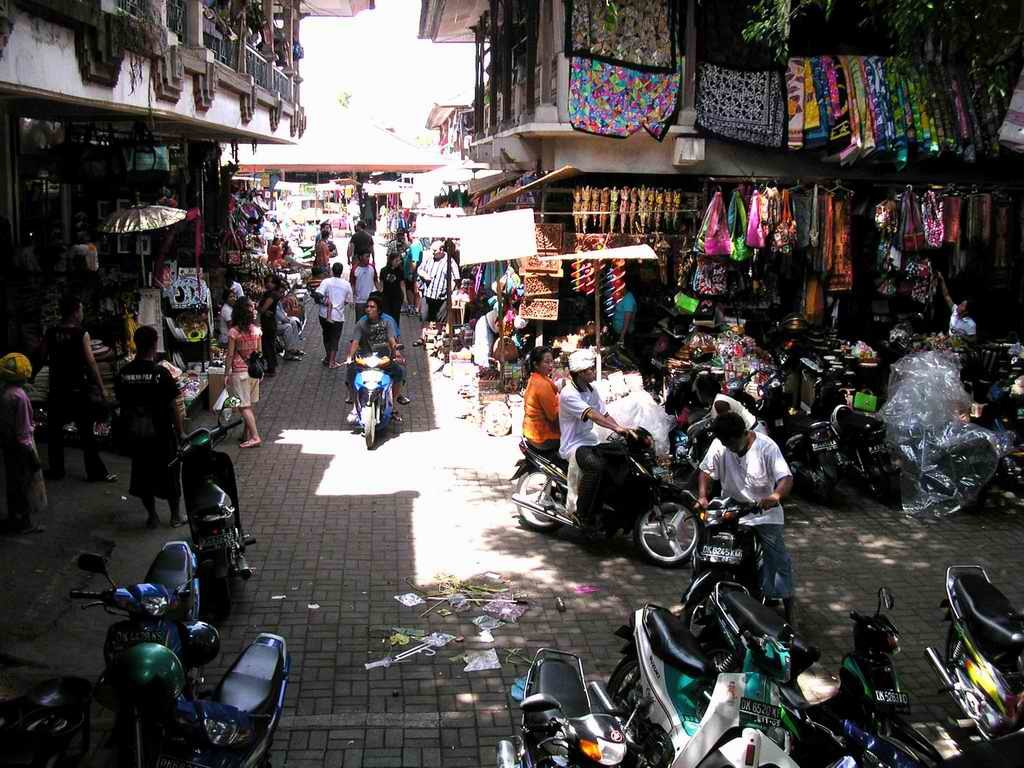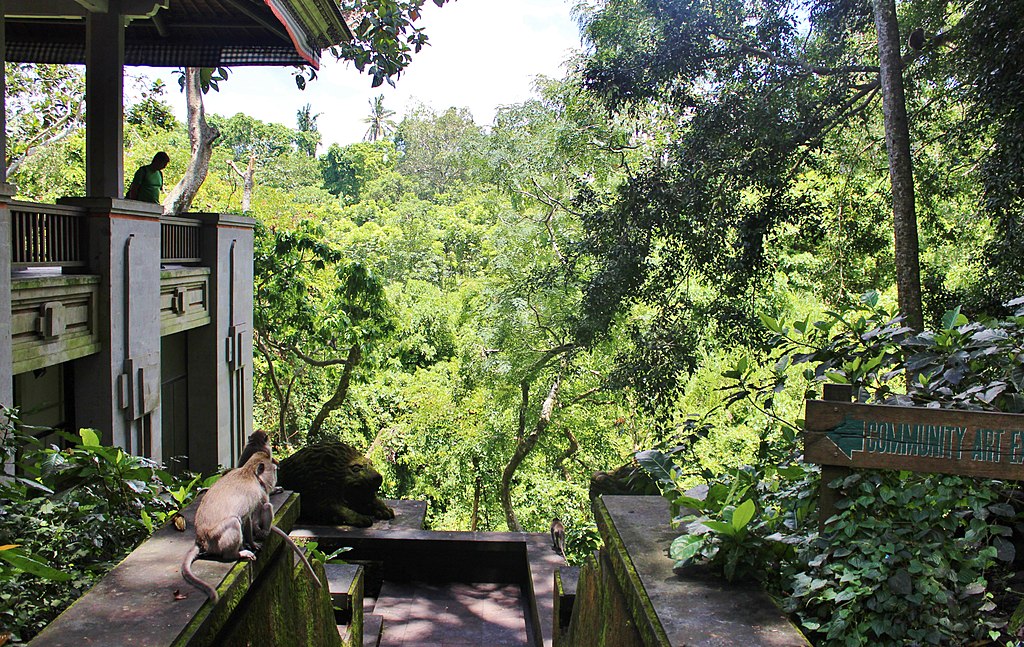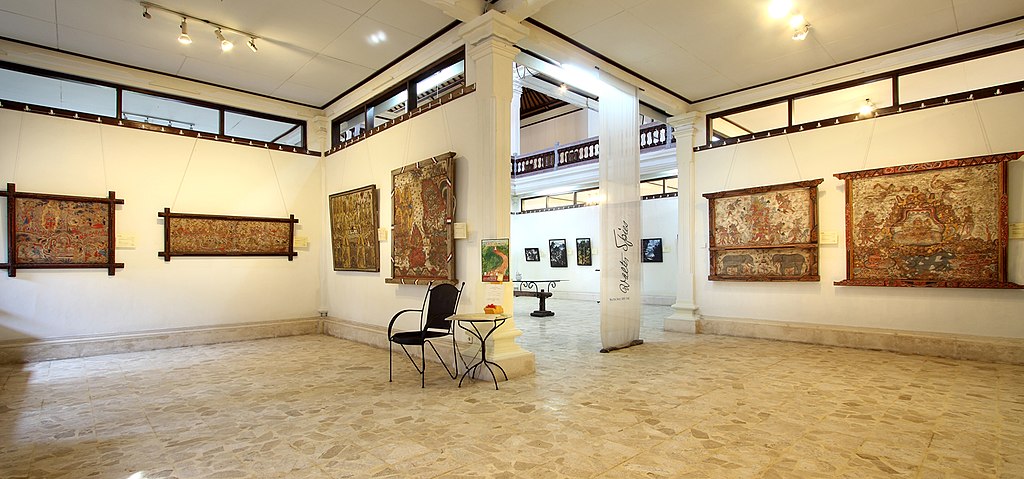Sanur
If you are looking for a peaceful place to spend a family vacation by the sea, Sanur might just be the place for you. With its white sand beaches, calm and shallow waters, children can swim safely while you sip a cocktail on your deckchair.
Sanur is one of Bali’s popular destinations and it’s easy to see why. White sand beach, protected lagoon, luxurious hotels, very good quality restaurants and calm throughout the city, it has something to please almost everyone. It’s only 30 minutes’ drive from Kuta, Seminyak and 40 minutes’ drive from Ubud.
Families, divers and retirees alike love it, but it can definitely win the hearts of many more people. In general terms, Sanur is more expensive than Kuta but cheaper than Seminyak.
Sanur is one of Bali’s oldest and most famous beachside destinations and attracts visitors by the hundreds with its stunning beach and restaurants. Quieter than Bali, Sanur is full of tourist attractions where you can stay, eat and drink, and will be the perfect place to relax for a few days before continuing your journey to other parts of the island or even to other islands, such as Nusa Penida. This little piece of paradise is a popular tourist attraction which, although it lacks some tourist infrastructure, will be the perfect place to take a short getaway from Sanur. Famous for its ornithological sanctuary, various breathtaking diving spots and its superb landscapes, do not hesitate to travel from Sanur to Nusa Penida if you want to discover another side of Bali!
With its four kilometers of beautiful white sand beaches, Sanur is known to have been Bali’s first real tourist and seaside destination from the first half of the 20th century. Today, the sand is still there but Sanur is more of a so-called secondary destination. The small city, which gossips say is sleepy, is in fact a good alternative to Kuta-Legian-Seminyak, with its overcrowded streets, its less clean beaches and its already legendary traffic jams!
The famous white and black checkered fabric (poleng), a notorious symbol of harmony in Balinese Hinduism and of opposing forces that intersect, is the emblem so well chosen of the rival station of Sanur, which we are going to draw here briefly the portrait. A passage by this long beach, which we reach so quickly via the bypass (motorway) just nearby…, a resort that is both old and modern, remains a guarantee of calm in comparison, even if the real tranquility is to be sought elsewhere on the island, in the north and east especially…
 Sanur beach, Bali. Magul, CC BY-SA 4.0, via Wikimedia Commons
Sanur beach, Bali. Magul, CC BY-SA 4.0, via Wikimedia Commons
What to do in Sanur?
1. Sanur Beach
It is located in a lagoon east of Bali. Sanur Beach is very family friendly. Children can play at the edge of the shallow water, and parents can watch them while having a drink in one of the many bars that line the beach. If you are looking for a calm and safe beach, this is the beach for you!
The sunrises in Sanur are very beautiful to see especially since the seafront of Sanur offers views of Nusa Penida and pretty scenes of local life in the middle of tourists with its fishermen or even the portions of public beaches of Sanur where the locals come to spend time with family or lovers at the end of the day, especially on weekends. What we like is the long pedestrian promenade that runs along the sea, you can easily walk or cycle there.
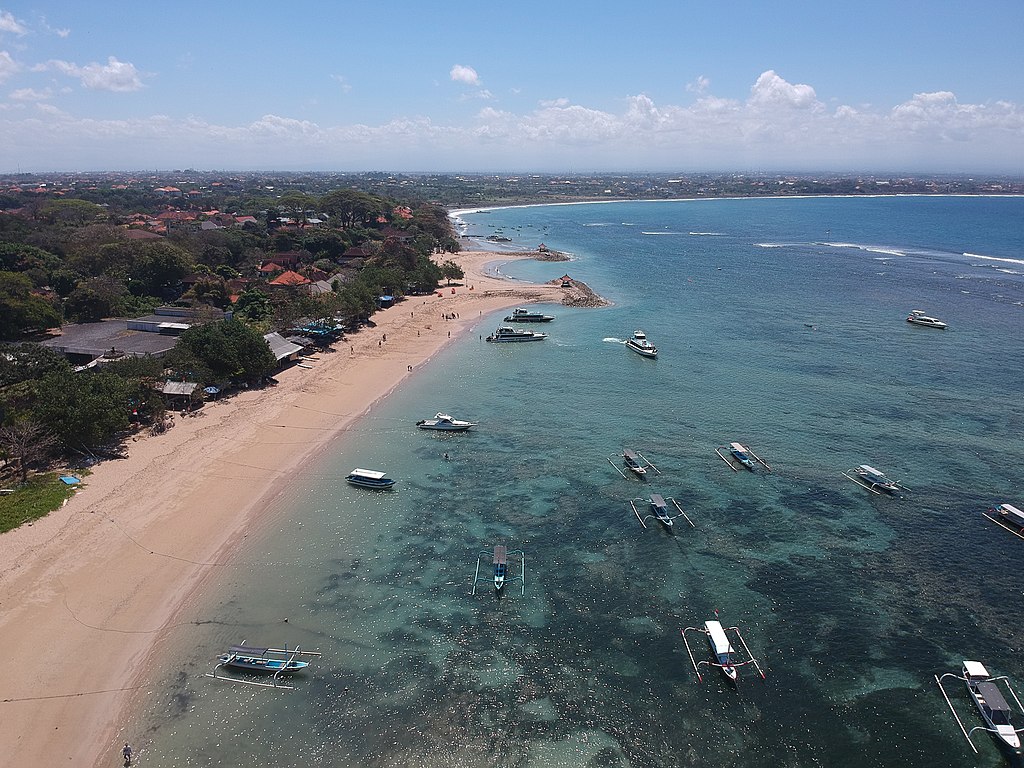
Sanur Beach, Bali. Magul, CC BY-SA 4.0, via Wikimedia Commons
2. Pasar Sindu (local market)
The local Pasar Sindu market is a must. When you arrive around 10am, it was already almost a little late and some shopkeepers had already been tidied up. It must be said that with the humid heat, life begins at 5 a.m. in Bali. But you can discover fruits and vegetables that you might not see every day. Like the Salak, a curious fruit in the shape of a snake’s egg (it is also called snake fruit). After peeling it, its texture a little rough, but its taste is close to the apple. Nice discovery!
In the market, there are also many flower stalls for making daily offerings in front of houses and temples. According to local belief, this offering protects and blesses. Before going to work, the Balinese place an offering and say a prayer in front of one of the many small temples in each street. In these flower offerings, the Balinese sometimes also add sweets or crackers, then burn incense. Which diffuses a typical and unique smell in the streets.
3. Le Mayeur Museum
This small museum located north of Sanur hides works of art and the personal history of the painter Adrien-Jean Le Mayeur de Merpres, a Brussels artist in love with Bali and the shores of Sanur. The Le Mayeur Museum is located in the main part of Sanur Beach, behind many art and souvenir stalls. This museum was actually the home of Adrien and his wife who was a Balinese dancer named Ni Wayan Polok Tjeoglik. After Adrien’s death, this house was transformed into a museum.
Unfortunately the beautiful paintings of Le Mayeur are poorly maintained by the Indonesian State and are deteriorating which is a shame.
4. Fishing
On Sanur beach, many fishing companies offer day trips, so you can choose what kind of fishing you want to do. If you want more authenticity, you can also join the local fishermen on a small boat. It’s a great experience and most of the time you can eat your own caught fish afterwards!
5. Dive
The coral reef is mostly damaged, which makes it less attractive to divers. If you want to dive in the most beautiful spots in Bali, a day trip with Dune Atlantis to the Gilis Islands, Padang Bay or one of our many other destinations, is the ideal solution. Read also: Best Dive Spots in Bali
6. Fastboat to Nusa Islands
From Sanur, you can take a fastboat to one of the islands of Nusa. The fastboat only takes half an hour to reach Nusa Penida, Nusa Lembongan or Nusa Ceningan.
Read also: Nusa Lembongan or Nusa Penida | What to choose between the two islands?
7. Visit the temples
-
Pura Segara
This temple, visible from the street, is dedicated to the gods of the sea. At the entrance, you will see a black portal guarded by two black demons, while the altar in the central courtyard will give you a superb view of the ocean. .
Address: Jl. Segara Ayu (near Segara Village Hotel)
-
Pura Mertasari
Here is a temple that is worth the detour, especially after the spring equinox. Indeed, the Balinese attach great importance to this temple which hosts rites of black magic. During this annual ceremony, a warrior dance is performed, sometimes ending in a violent trance. This temple is located at the southern end of Sanur Beach. So you can easily get there after your walk on the beach. Indeed, the latter extends over more than 4 km and is very popular with joggers.
Address: Jl. Merta Sari, Sanur, Bali.
-
Pura Blanjong
A temple to go and see because of its age! Vestige of an ancestral era, this very old temple holds a column dating from 914, attesting that the Indian influence was already present at that time. It is still animated today by the Balinese who continue to perpetuate the tradition and to honor the deities with offerings. Read also: Must Visit Temples in Bali | You need to visit one of them at least once during your stay in Bali
Address: Jl. Danau Poso, Sanur, Bali

The Blanjong Temple, Sanur, South Denpasar, Bali. DayakSibiriak, CC BY-SA 4.0, via Wikimedia Commons
8. Try the swings overlooking the sea at Dream Island Park
If you have prepared your trip to Bali, you must have heard of the famous swings in the ocean on the Gili Islands. Note that in Sanur, you can also test these pretty swings with your feet in the water at Dream Island, an ideal park to spend the day with the family. Located on Mertasari Beach, one of the locals’ favorite beaches, Dream Island is also the perfect place to try out various activities such as camel and horse riding, windsurfing, canoeing, diving and snorkeling. You can also enjoy authentic Indonesian meals in their restaurant and relax by the beach in their spa for an unforgettable day in Bali.
Dream Island
Entry: IDR 200,000
Address: Jalan Pengembak No.44, Sanur Kauh, Denpasar Selatan, Kota Denpasar, Bali
Hours: daily from 9 a.m. to 7 p.m.
Telephone: +62 812-3629-7088
9. Visit the abandoned Festival Taman amusement park
If you have children who love ghost stories or if you are a big fan of all things scary yourself, be sure to visit the Taman Festival, one of the spookiest places in Bali! The Taman Festival is a large amusement park in Sanur whose works have never been completed. Since the park and its crocodile pit were abandoned 14 years ago, it has literally collapsed, leaving behind a huge amusement park potential that would no doubt have been very successful…
Today, with crumbling buildings threatening to fall at any moment, missing tiles and treacherous steps, locals refer to this park as a “ghost town”.
Taman Festival
Address: Jl. Padang Galak No.3, Kesiman, Denpasar Tim., Kota Denpasar, Bali.
10. Swim with sharks with Bali Sharks on Serangan Island
Give your children a unique experience while educating them about environmental conservation.
Unfortunately, unregulated shark fishing is still a reality in Bali, and it is now very rare to see the reef sharks that once prowled the coral-lined shores of the Island of the Gods. Bali Sharks is the island’s premier shark conservation program. The founders even created a man-made “shark island” in Serangan.
Reef sharks, mostly black and white tip sharks, are kept in large pens on the high seas. The sharks are brought near the sanctuary after being bought from fishermen or after being rescued from entanglement in nets. Eventually, healthy sharks are released back into the wild. Embark on this 3-hour ecological excursion that will make you overcome your fears by living an unforgettable experience!
Bali Sharks
Website: http://www.balisharks.com
Address: Jalan Tukad Punggawa No. 25, Serangan
Telephone: +62 361 9965101
Hours: daily from 7 a.m. to 3 p.m.
11. Enjoy an unforgettable underwater walk at Bali Seawalker
Treat your children to a unique water experience on the Island of the Gods with Bali Seawalker! The waters surrounding Bali are teeming with stunning marine life and with Bali Seawalker, even little travelers can swim with the fish or snorkel to admire the aquatic wonders that populate Balinese waters.
Bali Seawalker
Website: http://www.seawalker.co.id
Address: Puri Santrian, Sanur, Denpasar City, Bali 80228
Hours: daily from 9 a.m. to 2 p.m.
Phone: 0813-3739-9432
12. Admire the kites at the Bali Kite Festival
Looking up at the blue skies of Bali, it’s rare not to spot at least one kite, and once a year during the month of July / August, the sky is filled with these colorful wonders, during the Bali Kite Festival in Sanur. The Bali Kite Festival brings together kite teams from all over the island on Padang Galak beach. Kites are an integral part of Balinese culture and the festival is accompanied by traditional gamelan music.

Morning in Sanur Beach. Danangtrihartanto, CC BY-SA 4.0, via Wikimedia Commons
Where to eat in Sanur?
There are many places to eat, here are some of our favourites:
Big Garden Corner
Big Garden Corner is a feast for your eyes and your taste buds! As well as serving delicious, mostly Western-style food, this restaurant also has a large park where your kids can have fun in whimsical huts perched in trees, with lots of colorful umbrellas.
Address: Sanur, Jl. By Pass Ngurah Rai, Kesiman, Denpasar Sel., Kota Denpasar, Bali 80237
Hours: daily from 9 a.m. to 9 p.m.
Warung Little Bird
This little warung is the perfect place to spend a relaxing evening listening to reggae music with a good beer and delicious local specialities! Food and cocktails are perfectly priced and all served by friendly servers. In this local restaurant with a friendly atmosphere, you can even play a piece on the guitar if you feel like it.
Address: Jl. Danau Tamblingan No.34, Sanur, Denpasar Sel., Kota Denpasar, Bali 80228
Opening hours: every day from 11 a.m. to 11:30 p.m.
Warung Dapoer Oma
Located a little further than Sanur, this warung is totally worth the trip! This restaurant in the form of a buffet-showcase presenting a wide choice of local specialties, to accompany with white rice, yellow rice with turmeric or red rice. You have the choice between vegan/vegetarian dishes but also with chicken, beef or fish.
Address: Jl. Danau Buyan no. 34, Sanur, Denpasar 80228, Indonesia
Telephone: +62 361 4721864
Massimo Bali
Do you miss Italian food? So don’t hesitate, go to Massimo Bali: they serve the best pizzas and pastas in Sanur! Everything is homemade and the recipes have been carefully concocted by the Italian chef, Massimo, who has been living in Bali for several years. Everything is so good here that this restaurant is always full, so be sure to book a table in advance if you want to taste delicious wood-fired pizzas or real pasta cooked by an Italian starred chef.
Address: Jl. Danau Tamblingan 228
Opening hours: every day from 11 a.m. to 11 p.m.
Telephone: +62 (0361) 288942
History
The word Sanur is made up of the roots saha and nuhur, a denomination echoing the passion for travel and discovery. Originally, it was a small fishing village populated by members of the Brahman caste.
It was at Sanur that the Dutch landed in 1906, and it was from this small village of fishermen and farmers that they reached Denpasar to cause the famous puputan (collective suicide) of sinister memory. Sanur was a small fishing and farming village where there was nevertheless a high proportion of Brahmins.
Later, in the 1930s, Sanur welcomed the photographer Jack Mershon and his choreographer wife Katharane, and several artists such as the Belgian Adrien Jean Le Mayeur de Merfrès who married a young Balinese dancer (Ni Pollok) from Legong dance, renowned for her talent and her beauty.
The German Neuhaus brothers also settled there and created an aquarium and an art gallery. These foreigners, all seduced by the Balinese way of life, are part of the wave of Europeans and Americans who, in Sanur as in Ubud, contributed to making Bali known as the last of the paradises. Tourists began to flock from all over the world and very curiously, like today’s tour operators, bought a 5-day package to visit the island. The Dutch East India Company decided to build a hotel in Sanur (the Sindhu Beach Hotel) and another in Kuta (the Kuta Beach Hotel) in the 1950s.
This is the first attempt to build a Balinese-style hotel relayed by a tourist agency. Under the impetus of President Sukarno, the Bali Beach Hotel was built as war reparations with Japanese capital in 1962, but was not inaugurated until 1966 shortly after the dramatic events that followed the coup d’etat.
Thereafter, in order to counterbalance the disastrous experience of the architecture of Bali Beach which moved the religious and administrative authorities of the island, the first hotel to create a Balinese atmosphere and to found a myth was the Tanjung Sari, became famous in France by Muriel Cerf’s novel, Le Diable vert.
He persisted in representing the model of indigenous tourist architecture, mixing traditional Balinese arts with elements of modernity. Gradually, land prices soared, as Sanur turned out to be Bali’s only resort town.
The Tanjung Sari, of modest size, remained for some time an almost cheap hotel, while the newcomers attracted rather an affluent clientele. Now, Sanur remains the village of Indonesian high society and jet-society, which sets its sights on the most chic hotels, the most southerly.
Its beaches aren’t particularly beautiful, with reefs erupting at low tide in the distance, but the village atmosphere gives off a slightly old-fashioned scent. The tourist manna, older than in Kuta, prefers a ceremonial tranquility. And, while the “summer visitors” are sunbathing in the sun, around certain temples, people still indulge in black magic, a common practice in this part of the island… Evoke Sanur to any Balinese: he will associate black magic and sorcerers with it. The wise advise not to venture late at night in its dark streets…
Sanur town center
Sanur’s bustling town center full of restaurants and bars
Downtown Sanur is not lacking in charm either. Many restaurants, both local and western, are dotted around the streets of Sanur. It is thus easy to leave your hotel and enjoy a meal without necessarily having to take a taxi.
The variety of restaurants in Sanur is great for the pickiest of palates, and the quality is generally very good.
Although there are fewer of them than in other cities in Bali, the bars of Sanur can also be friendly and allow you to watch a football match, play pool or dance with a fresh bintang in your hand in a good-natured atmosphere.

Sunrise in Sanur Beach. 2ndoct, CC BY-SA 4.0, via Wikimedia Commons
Who frequents Sanur?
Sanur is a small melting pot made up of locals, expatriates, tourists and other people living in Bali who come to spend an afternoon in Sanur.
Here are the people you will surely meet in Sanur:
Expatriate pensioners: the cliché of Sanur
Expatriate pensioners are a bit of a cliché in Sanur. Like every cliché, there is a part of truth. Many Western expatriates have indeed made Sanur their home.
They appreciate the calm and safety of its beach, the presence of many restaurants, the ease of access to the rest of the island and the unique atmosphere that reigns in this place which has kept its soul of a small village.
Families on holiday in Sanur
Sanur is frequented by many families, and it is easy to see why. Sanur is indeed one of the versatile destinations in Bali.
Parents can enjoy the calm of the beach, the good gastronomy, while the children can have fun safely in the swimming pools of the hotels, in the lagoon or during nautical activities. All in the comfort of a luxurious, even very luxurious hotel that quickly makes you forget the problems of everyday life.
Local tourists on resort in Bali
Sanur is a very popular city with locals. The luxurious hotels do not disorient the most urban tourists of Jakarta who appreciate the comfort between their Balinese escapades.
But Sanur is also popular with Balinese living in Renon or East Denpasar who often go there on weekends to fish, spend time on the beach with family or meet friends in a restaurant.
Divers passing through as expatriates
The east coast of Bali concentrates many diving spots. Many diving schools are based in Sanur and allow those who stay in Sanur to be taken to the most famous spots on the island.
It is also possible to scuba dive directly from Sanur into the lagoon, although most divers prefer to venture a little further north. In any case, you are likely to come across many divers in Sanur, whether they live here or are just passing through.
Which audience can Sanur appeal to?
Now that you have a better idea of what Sanur looks like, here’s what kind of people the town is most likely to appeal to.
You’ll like if you like quiet places
If you are looking for calm during your vacation in Bali, then Sanur is a very good option.
It combines the calm of lost coves with the practical aspects of a seaside resort, all in a rather distinguished and discreet style.
This relative calm can therefore please almost everyone depending on their temperament: young people, couples, families and of course retirees.
Is a good base for divers
If you plan to dive often during your stay in Bali, then Sanur is a very good base.
The most famous spots on the east coast are only a few minutes away by car or boat, and it is even possible to cross to Nusa Lembongan, Nusa Ceningan or even Nusa Penida during the day.
Settling in Sanur allows you to be in a central place for diving, all in greater comfort than what is currently found near more famous spots.
If you want a central destination in Bali
This place is really easy to access, and this is a big advantage for an island like Bali that is often plagued by traffic jams.
Traffic jams are rare both in Sanur and its surroundings. It is therefore very fast to get to Nusa Dua, to Amed, to Kuta and Seminyak and even to Uluwatu. The only really bottled up point in Sanur is when you leave the “bypass” to cross Denpasar (to go to Canggu for example). Apart from these rare cases, all Bali is nearby or almost.
Is a versatile destination for families
Families often like Sanur very much because everything is possible there.
The activities are numerous, the access is simple, the accommodation comfortable and all the infrastructures are in place to spend a stay without organizational headaches.
Who is Sanur likely to displease?
Sanur may be a particularly versatile destination, as all tastes are in nature, not everyone will like Sanur. Here are those who may not find their account.
Sanur is not the most festive place in Bali
If you came to Bali for the party, you won’t find many in Sanur. Sanur is certainly relatively lively, but the entertainment is more like a good family man: “little pub, small restaurant”, than truly a party place with beach bar, big nightclubs and other wild parties.
If you absolutely want to party in Bali, Kuta, Seminyak and Canggu are three particularly lively cities, more or less young, each with their own style and specificities. But unfortunately, Sanur is likely to be too boring for you.
You won’t like it, if you want a rural Bali experience
We are not going to lie to each other, Sanur is a haven of peace in the seaside resorts of Bali. But it remains a westernized seaside resort.
Is therefore not quite the very authentic rural experience that some seek. That said, it’s far from the worst place to see some aspects of Balinese culture, despite the tourism.
Some places in Sanur are not very recommendable
It has a sometimes sulphurous reputation with locals and expatriates, even if the majority of tourists who pass there do not even realize it.
The city is indeed one of the hotspots of Bali for those, foreigners as well as locals, who are looking for “girls of joy”. Admittedly, we are still light years away from prostitution in the eyes of all as in Thailand, but it is possible to come across locals, tourists and even expatriates who are there for reasons other than the white sand of Sanur.
If you want to avoid these places, just don’t go to the (brothel) houses marked with an “X” and don’t go to the bars where there are – oddly enough – almost only women seem to be waiting for something or someone.
Notes: opening hours and rates are subject to change without prior notice.
Main photo credit: Wandemokkori via Pixabay
The Best Beaches in Bali | Most famous beach during your holiday
Have you booked your private villa in Seminyak center?
Nestled within Seminyak Center, Bali, Villa Carissa beckons with a private swimming pool and enclosed garden, ensuring utmost privacy. Secure your private pool villa reservation with us today.
Ideal for family, friends, or a romantic escape, Villa Carissa in Seminyak Center serves as the ultimate launchpad for discovering Bali’s allure while relishing a serene getaway. Unveil the charm of Bali’s attractions and bask in relaxation at Villa Carissa—an oasis of tranquility. Book now to embark on your perfect Balinese vacation.

